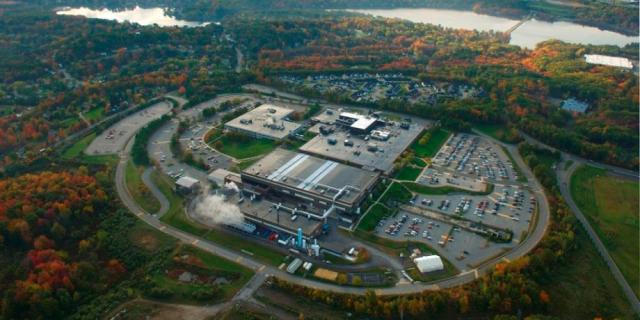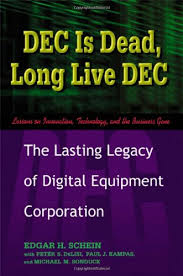I was saddened to hear the recent news that Intel is closing its Hudson MA semiconductor fab. It’s 35 years old, and couldn’t be upgraded to the latest process nodes. It’s still using 200 mm diameter wafers and a 130 nm feature size, whereas the latest is 450 mm and 22 nm. Intel likes to make all their fabs identical, right down to the color of the paint, so that they can easily transition products from one to the other, but they didn’t actually build this one. Digital Equipment Corp did, in 1979, and gave it a big upgrade in 1994. It was sold to Intel in 1997 as part of then-CEO Robert Palmer’s break-up of the company, and also as part of a patent settlement suit.
I had my first real job there. When I first arrived there fresh out of school in 1981, I thought I was Entering the Future. The plant had its own helicopter service that shuttled people among DEC’s plants and to the airport. It’s up on a hilltop, with a view of hundreds of square miles of rolling forest. The hill was an old apple orchard, and the remaining trees would still blaze with flowers in the springtime. DEC’s founding CEO Ken Olsen got then Governor Mike Dukakis to give it its own exit off of I-495, the outer ring road around Boston. All through the 1980s it built the most sophisticated microprocessors in the world, and in the 1990s, with the Alpha line, it built the fastest. This was how high-tech was supposed to revive even this old, gray state.
I was on the design side instead of the fab. I worked in Building 2, there in the back left, until 1992. At that time I had a desktop workstation that was fully networked to server farms and laser printers, with a bitmap display and a real OS, VMS. It was pretty much what I’m typing on now, except much more reliable and twenty times as expensive.
That cost is what did DEC in. They knew how to build far better computers than the PC makers could, and they knew how to build them cheaply, but they didn’t know how to get the company to do it. DEC did actually come out with its own PC line in the early 80s, the DEC Rainbow, which ran both CP/M and MS-DOS, but it wasn’t quite compatible with IBM PCs. The DEC engineers didn’t realize that naive DOS programmers would access the x86 hardware directly instead of going through the OS, and so their code ran only on specifically IBM hardware. Maybe people hated DOS even then, and trusted IBM more.
So the Rainbow didn’t make much money compared to the VAX lines, and was abandoned early. Even the workstation market, which had machines in the $10K to $20K range, wasn’t that lucrative for DEC. They liked big machines with big markups, and customers who cared about reliability and service. They also liked to do things right, instead of quickly and cheaply, and that wasn’t the PC way.
However, DEC did tremendously well in the late 80s. It peaked at 100,000 employees and $14B in sales ($25B today), but the writing was on the wall. A disastrous project, the VAX 9000 ECL mainframe, and the looming threat of PCs caused Ken Olsen to resign in 1992. He was replaced by the aforementioned Palmer, who had been head of the Semiconductor Engineering Group in Hudson, and had previously founded Mostek. The engineers in Hudson mocked him for his thousand-dollar suits and blow-dried hair. “Doesn’t he realize we have a dress code?” we wondered. He also drove a Porsche, but with an automatic transmission. He quickly started layoffs and sales of divisions, and finally sold the whole company to Compaq in 1998, with a $20M golden parachute for himself. I don’t think he lives in Massachusetts any more.
Ed Schein and others talk about what went wrong in “DEC is Dead, Long Live DEC”. He reviews the company history and interviewed a lot of alumni. He thinks the core reason for both DEC’s success and its failure was Olsen’s management philosophy – set people going and then get out of their way. Trust them to do the right thing. They who propose, dispose. This was liberating in the 60s and 70s. People were treated as grown-ups instead of pieces of equipment. They explored a huge range of product ideas and were able to innovate everywhere. It was engineering heaven.
But as the company grew larger, it was no longer possible to manage by personal contact. No one at the top knew who was doing what, and whether they were any good. They needed more formal mechanisms to prevent people from simply protecting loyal underlings and pet ideas. They got hung up on their one great business, minicomputers, rather than shifting to networking, or servers, or small machines, any one of which would have been a good business. When the board of directors insisted that the company change focus and seriously downsize, Olsen quit. That felt like betraying his people.
He was a paternalist, but he treated people far better than companies do today. DEC actually did hire ignorant young grads like me and teach them to be useful. They didn’t expect hires to have already invested their own time in learning a technology, as companies do today. As a result, Schein found that a remarkable range of people had fond memories of their time at DEC. The company pioneered a wide range of technologies, but more importantly it trained a generation of people in IT.
That sounds rather vague, so let me be more specific. If you’ll pardon a shout-out to old colleagues, let me list the people I knew from the Semiconductor Engineering Group and what their highest positions since DEC have been. Links are to their Wikipedia entries:
- Intel Fellows: Bill Grundman, Joel Emer, Matt Adiletta
- Intel: Jim Pappas, driver of USB and Infiniband, and Bill Herrick, Itanium leader, Bill Bowhill, processor design leader
- Xilinx: Moshe Gavirelov CEO, Victor Peng CEO (and then a President at AMD), Hugh Durdan VP, Liam Madden VP
- AMD: Dirk Meyer CEO, Rich Heye VP Microprocessors, Rich Witek Fellow, Norm Rubin Fellow, Jim Montonaro Fellow (also Alchemy founder), Ray Stephany Fellow
- Apple: Pete Bannon and Jim Keller, Ax processor architects
- Google Fellow Dick Sites
- Analog Devices VP Dan Leibholz
- Analog Devices Fellow Chris Mayer
- AMD Fellow, Tilera VP John Brown
- Cavium VP and founder, and Marvell VP Anil Jain
- Rambus VP Mike Uhler
- C-port founder Larry Walker
- Oasis Semi founder John Koger
- Sand Video and Immedia founder John Iler
- Nvidia VP Frank Fox
- SiCortex founder Matt Reilly
- Stargen founder Todd Comins
- Princeton prof Doug Clark
- Brown prof Iris Bahar
- Nvidia VP Dina McKinney
- Unisys VP Bob Supnik (also creator of the great computer history site SIMH)
That’s a fair fraction of the modern chip industry! Special mention should be made of Dan Dobberpuhl, now passed, but the ninja master of microprocessor design. He led the designs of one of the smallest processors (the T-11, a PDP-11 in only 12K transistors), one of the fastest (the Alpha 21064), and one of the most power-efficient (the StrongARM series). He left DEC to found SiByte in ’98, which was later sold to Broadcom for $2B, then founded PA Semi, which was bought by Apple in 2008 for $275M. It’s now the core of their processor group, and at the heart of the iPhone and iPad. He was IEEE Solid State Circuits Engineer of the Year in 2003, and elected to the NAE in 2006. He had a sensei’s calm in the midst of chaos and cancellation, and the ability to ask the important question.
So DEC was a net generator of talent and technology. Most firms are net consumers. They aren’t missed when they go under. I hope that people at, say, Google will have similarly fond memories of their firm when it gets inevitably displaced!



You forgot John Iler
So I did! Fixed.
Victor is president of AMD now.
Pingback: Intel to sell historic Massachusetts R&D site to developer - DUK News
Pingback: Intel to sell historic Massachusetts R&D site to developer • The Register – Satori Pulse
Pingback: Intel to sell historic Massachusetts R&D site to developer – Washington Dailies
Pingback: Intel to promote historic Massachusetts R&D website to developer - news@enetworklink
Pingback: Intel to sell historic Massachusetts R&D site to developer • The Register - Licking County Times
Pingback: Intel to sell Massachusetts R&D site, once home to its only New England fab – Wealth Creation Investing
Pingback: Intel to sell historic Massachusetts R&D site to developer • The Register |
Pingback: Intel to sell historic Massachusetts R&D site to developer • The Register – UK Poperty Guides
Dick Sites has a remarkable talent for explaining incredibly complex ideas in a way that they seem obvious and almost banal.
Until he leaves the room and you are on your own once again.